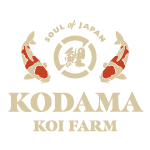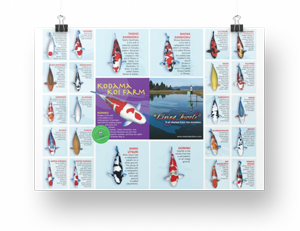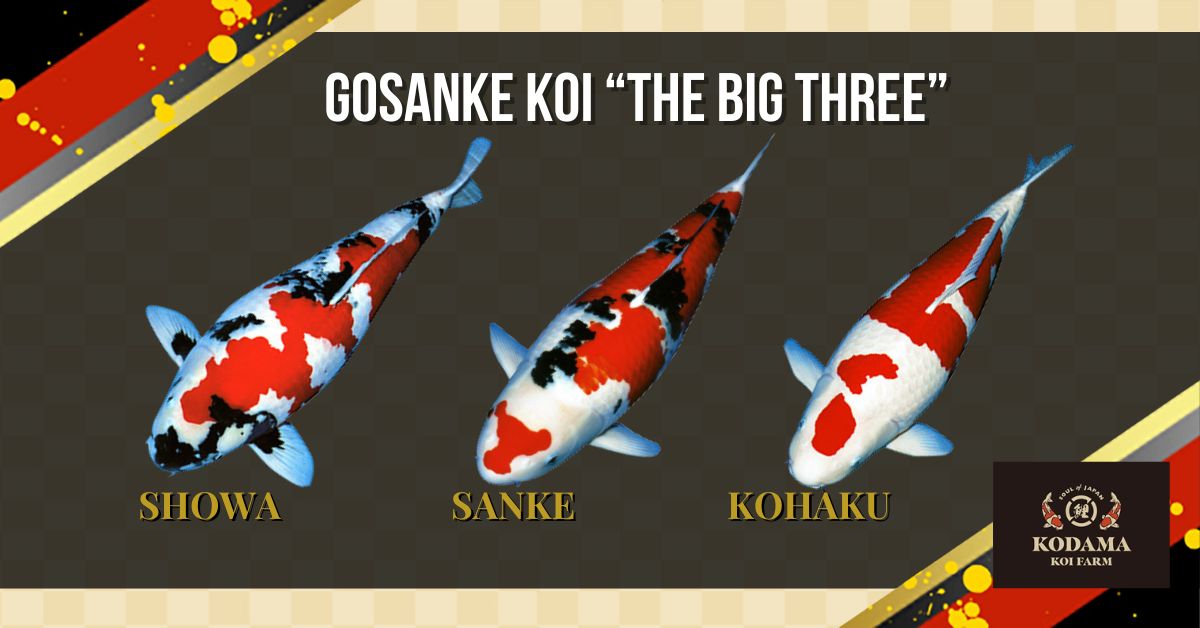
What is Gosanke Koi?
The term “Gosanke” (goh-SAHN-keh) refers to three primary koi varieties: Kohaku, Taisho Sanke, and Showa Sanshoku. These koi are celebrated for their aesthetic appeal and play a significant role in competitions and private collections worldwide.
History and Origin of Gosanke Koi
Gosanke koi, consisting of the Kohaku, Sanke, and Showa varieties, trace their origins to the Niigata region of Japan, a place renowned as the birthplace of Nishikigoi. The history of koi breeding in Niigata dates back to the early 19th century, when farmers began selectively breeding wild black carp (Magoi) for unique color patterns. Over time, this practice evolved into an art form, leading to the creation of the stunning ornamental koi we see today.
Kohaku, the oldest variety among the Gosanke, emerged in the late 19th century as breeders perfected the balance between its white base and bold red (hi) markings.
The Taisho Sanke followed during the Taisho era (1912–1926), with its distinctive white body adorned with red and black patterns. Showa, the youngest of the trio, was introduced during the Showa period (1926–1989), known for its striking combination of white, red, and black that creates a more dynamic and dramatic appearance.
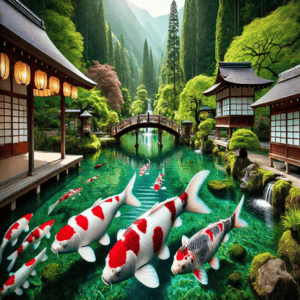
The refinement of Gosanke koi required generations of meticulous breeding and a deep understanding of genetics, coloration, and pattern development. These koi became a symbol of excellence and are now the cornerstone of koi competitions worldwide, often celebrated for their elegance, symmetry, and vibrant colors. Today, Gosanke koi continue to be the most sought-after varieties among koi enthusiasts and collectors, representing the pinnacle of Nishikigoi artistry. Their history reflects a harmonious blend of tradition, dedication, and passion that has elevated koi breeding to a revered cultural heritage.
Key Characteristics of Gosanke Koi
Heres what sets these koi apart, from their striking patterns to their significance in koi appreciation and breeding.
Kohaku
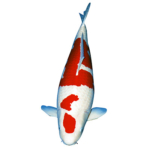
The Kohaku koi, a classic member of the Gosanke group, is renowned for its striking red and white contrast. As one of the oldest and most iconic varieties, it symbolizes simplicity and refinement, making it a timeless favorite and a centerpiece in koi ponds worldwide.
- Appearance: Pristine white body (shiroji) adorned with red (hi) patterns. Purity of white and depth of red are key.
- Symbolism/Significance: Associated with purity and elegance in Japanese culture.
Taisho Sanke
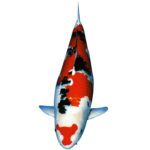
The Taisho Sanke, a stunning member of the Gosanke group, is celebrated for its perfect blend of red, white, and black markings. Originating in the Taisho era, these koi embody elegance and cultural significance, symbolizing harmony, beauty, and prosperity in Japanese koi breeding.
- Appearance: White base with red and subtle black (sumi) markings. Balance of three colors determines quality.
- Symbolism/Significance: Prized for their refined and harmonious patterns.
Showa
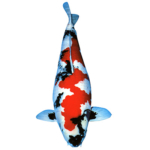
The Showa Sanshoku is a captivating koi variety known for its dramatic color contrast and dynamic patterns. As part of the revered Gosanke family, this koi commands attention in any pond.
- Appearance: Black base interwoven with red and white patterns. Bold contrast between colors is striking.
- Symbolism/Significance: Patterns are typically more dynamic and dramatic compared to Kohaku and Sanke.
How to Identify High-Quality Gosanke Koi
Selecting a high-quality Gosanke koi—Kohaku, Sanke, or Showa—requires attention to key traits that define competition-level fish. Experts judge koi based on color vibrancy, pattern balance, body structure, and skin quality.
| Trait | Kohaku | Sanke | Showa |
|---|---|---|---|
| Base Color | Pure white (shiroji) | Pure white (shiroji) | Deep black (sumi base) |
| Red (Hi) Pattern | Even, bold, well-defined edges (kiwa) | Should not touch fins; crisp kiwa | Mixed with sumi for dynamic contrast |
| Black (sumi) Pattern | None | Subtle, placed on body only | Bold, appearing on head & body |
| Body Shape | Strong, torpedo-like | Sleek and well-balanced | Thick, powerful appearance |
Spotting Imperfections
- Faded colors indicate poor genetics or health.
- Uneven sumi or blurred kiwa reduce aesthetic appeal.
- Asymmetrical patterns can affect competition scoring.
Young vs. Mature Gosanke Koi
Young koi may have incomplete sumi development, especially in Showa. Patterns refine over time, with black deepening and red becoming richer. Evaluating a koi’s potential requires understanding how colors and patterns evolve with age.
Discover the Beauty and History of Gosanke Koi – Watch Now!
Explore the three most popular Gosanke varieties: Kohaku, Showa, and Taisho Sanke. Discover the unique characteristics that make each of these koi types stand out and why they are revered in koi culture.
Whether you’re a beginner or a seasoned koi enthusiast, this video offers a perfect introduction to these stunning fish. Watch now to learn more about the beauty and history behind Gosanke koi!
Why High-Quality Gosanke Koi Appreciate in Value
- Rarity & Demand – The best Gosanke koi are bred from top bloodlines, making them highly sought after. As they mature and their patterns develop, their value can increase significantly.
- Beauty & Prestige – A well-balanced Kohaku, a perfectly patterned Sanke, or a striking Showa can command a high price in competitions and private collections.
- Longevity – Unlike other ornamental fish, high-quality koi can live for decades, allowing their value to grow over time.
Factors That Affect Pricing
- Lineage & Breeder Reputation – Koi from elite breeders like Dainichi, Sakai, and Momotaro often start at higher prices due to their superior genetics.
- Pattern & Color Clarity – A crisp, vibrant pattern with well-defined edges (kiwa) and deep, rich colors is essential for high value.
- Growth Potential – Koi with strong body conformation and the potential to develop beautifully over time are highly prized.
How Auctions Set the Market Standard
I remember watching my first Kodama Koi Farm auction and being amazed at how competitive the bidding was. These auctions:
- Showcase elite Gosanke koi from Japan’s best breeders.
- Set benchmark prices that influence the global koi market.
- Allow hobbyists and investors alike to acquire top-tier koi with confidence.
If you’re serious about koi keeping, investing in Gosanke koi can be both rewarding and profitable!
Expert Tips for Getting Your Gosanke Koi
Choosing Gosanke koi for your pond is an exciting opportunity to add elegance and beauty to your collection. These koi are renowned for their vibrant colors and balanced patterns, but selecting the right ones requires careful consideration.
Koi Breeder Reputation
Choose a reputable breeder, like Kodama Koi Farm, known for high-quality Gosanke koi with strong genetics, vibrant colors, and proper care practices to ensure healthy, stunning additions to your pond.
Gosanke Koi Visual Quality
Select Gosanke koi with vibrant, uniform colors, balanced patterns, and smooth, glossy skin. Look for symmetry and bold markings that enhance the koi’s beauty as they swim gracefully.
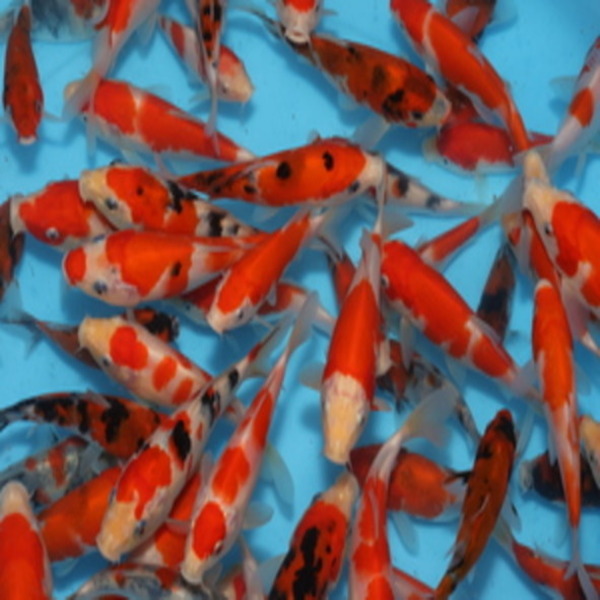
Koi Health
Choose active koi with clear eyes, intact fins, and no signs of disease. Ensure proper quarantine practices from the breeder to maintain your pond’s health and prevent potential issues.
Common Myths About Gosanke Koi
- There are several common myths about Gosanke koi that can create misconceptions among enthusiasts. One prevalent myth is the idea that Gosanke koi are only suitable for experts. In reality, while these koi are highly prized for their beauty and lineage, they can be enjoyed and cared for by hobbyists of all experience levels.
- Another misconception is that all Gosanke koi look the same. The truth is that each Gosanke koi is distinct, with individual patterns and color variations that make them uniquely captivating. Understanding these facts can help hobbyists appreciate the accessibility and diversity of these remarkable koi.
Types of Koi Fish Varieties Guide (PDF)
Koi varieties are ornamental fish derived from the common carp (Cyprinus carpio) and are prized for their vibrant colors, intricate patterns, and graceful forms. There are over 100 recognized koi varieties, categorized into distinct groups based on their colors, patterns, and scalation.
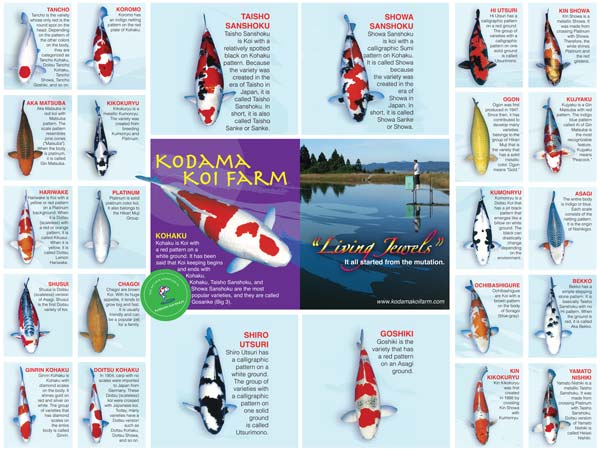
Download FREE Koi Variety Guide / Printable Poster:
Enter email to join our newsletter and receive koi variety guide printable file.
Key Groups of other Varieties of Koi
1. Gosanke: The most prestigious group of koi, considered the “Big Three,” prized for their elegant patterns, coloration, and strong body shape.
2. Utsurimono: Koi with a solid black base and bold contrasting colors like white, red, or yellow. Utsuri koi are dramatic and captivating, with their sumi patterns often resembling ink brush strokes.
3. Bekko: These koi have a solid base color of white, red, or yellow, complemented by simple black patterns (sumi). Bekko koi are subtle yet charming, appreciated for their clean, uncluttered designs.
4. Asagi: Featuring a light blue, net-like pattern across their back, Asagi koi have striking red accents on the belly, pectoral fins, and sometimes on the cheeks. They symbolize tradition and are among the oldest varieties of koi.
5. Shusui: A scaleless (doitsu) variant of Asagi, Shusui are characterized by a clean, reflective body and a striking row of dark blue or black scales along their dorsal line, complemented by red patterns on the sides.
Explore and learn about the various key groups of koi, continue reading….
Gosanke in Koi Shows
Gosanke koi often dominate koi competitions due to their aesthetic appeal and adherence to breed standards. For example, a champion Kohaku koi may feature perfectly balanced red patterns on a pure white background, exemplifying the pinnacle of koi breeding.
Gosanke koi are a testament to the beauty and artistry of Nishikigoi. Whether you are drawn to the elegance of Kohaku, the refinement of Sanke, or the boldness of Showa, these koi bring unparalleled charm to any pond. Explore the exquisite selection of Gosanke koi at reputable breeders like Kodama Koi Farm and elevate your koi-keeping experience.
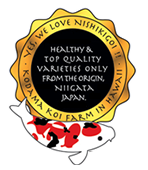
Why Gosanke Koi Are the Crown Jewel of Any Pond
Gosanke koi—comprising Kohaku, Sanke, and Showa varieties—represent the pinnacle of koi appreciation and are revered for their elegance, vibrant colors, and balanced patterns. As the cornerstone of koi competitions and personal collections, these majestic fish embody the artistry and dedication of generations of breeders.
Understanding the history, care, and characteristics of Gosanke koi will deepen your appreciation for their timeless beauty. Investing in Gosanke koi is more than an addition to your pond; it’s an invitation to immerse yourself in the rich cultural heritage and unparalleled artistry of Nishikigoi. If you have any questions or need guidance about Gosanke koi or any other koi varieties, don’t hesitate to reach out!
We’re passionate about helping you create the perfect pond and are excited to support your koi journey every step of the way.If you have any questions or need guidance about Gosanke koi or any other koi varieties, don’t hesitate to reach out! We’re passionate about helping you create the perfect pond and are excited to support your koi journey every step of the way.
